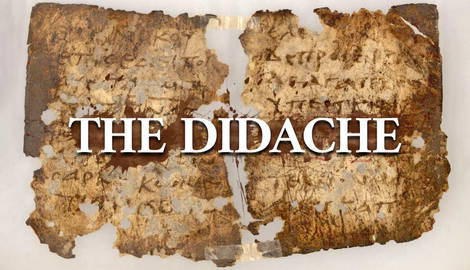
The Didache, also known as The Lord’s Teaching Through the Twelve Apostles to the Nations, is one of the earliest New Testament Christian documents, written in the early first or second century. The word “nations” in the title can also be defined as “Gentiles,” a word which means those who were not Jewish. The document is generally a document of Jewish Christian practices and their application toward their Gentile brethren. It is considered a part of the writings by the Ante-Nicene (meaning before the Council of Nicaea) Fathers, along with the writings of such figures like Clement of Rome, Polycarp of Smyrna, and Ignatius of Antioch.
An Early Christian Document

Throughout much of Christian history, the existence of the Didache was known through the writings of other early Christians, but its contents were generally unknown. A copy written in 1056 CE was discovered by Greek Metropolitan Bishop Philotheos Bryennios in Istanbul in 1873, with several translations in different languages published over the next few years.
The Didache Contains Historical Insights

While not considered part of the New Testament canon by most of the Christian church due to its unknown authorship and later date, the Didache provides much insight into the life of the early church. Almost from the beginning of the document, it makes continuous references both to the Old and New Testament. The Didache begins with a reference to the Great Commandment given by Jesus Christ: “There are two ways, one of life and one of death, but a great difference between the two ways. The way of life, then, is this: First, you shall love God who made you; second, your neighbor as yourself.” General directions of Christian living, most directly from the Gospels, are then given.
The Old and New Testament

The instructions later given throughout the book expand on some Old Testament law and New Testament rules. For Example: “You shall not practice magic, you shall not practice witchcraft, you shall not murder a child by abortion nor kill that which is begotten…” and “Be not prone to anger, for anger leads the way to murder; neither jealous, nor quarrelsome, nor of hot temper; for out of all these murders are engendered.”
It continues: “You shall not turn away from him that is in want, but you shall share all things with your brother, and shall not say that they are your own; for if you are partakers in that which is immortal, how much more in things which are mortal?” Next, The Way of Death, as opposed to the Way of Life, is a listing of many various sins, most of which are also found in various New Testament epistles.
Warnings and Practices

The next segment is a warning against false teachers and caution regarding eating food which was offered to idols: “but against that which is sacrificed to idols be exceedingly on your guard; for it is the service of dead gods.” The Didache here is a more cautious stance than the Apostle Paul writes in 1 Corinthians: “Food will not commend us to God. We are no worse off if we do not eat, and no better off if we do…” Next, the Didache addresses the method of Baptism, recommending immersion in “living water” (usually a flowing river) if possible, and pouring if not. Instructions on prayer and communion practices follow. It recites the Lord’s Prayer, nearly identical to how it is given in the Gospel of Matthew, and then has very specific wording and practice on the Eucharist (communion) ceremony.
Instructions regarding true and false prophets follow, with more specific instructions on how false prophets behave and how true prophets should be supported. Finally, the Didache instructs gathering on the Lord’s Day (Sunday, not Saturday, showing the practice was in place this early in Christianity), selecting bishops and deacons, and remaining faithful until the return of Jesus. The language in the final wording echoes that of the book of Revelation: “And then shall appear the signs of the truth; first, the sign of an outspreading in heaven; then the sign of the sound of the trumpet; and the third, the resurrection of the dead; yet not of all, but as it is said: The Lord shall come and all His saints with Him. Then shall the world see the Lord coming upon the clouds of heaven.”
In Summary

The Didache is an interesting look into early Christian beliefs and practices, and shows how traditions and ceremonies of early believers had already evolved. Practices regarding Baptism, the Eucharist, and church hierarchy are already being formed at this time. Acknowledgment of which apostolic writings are proper for usage is also showing early usage of scriptures by Christians.










